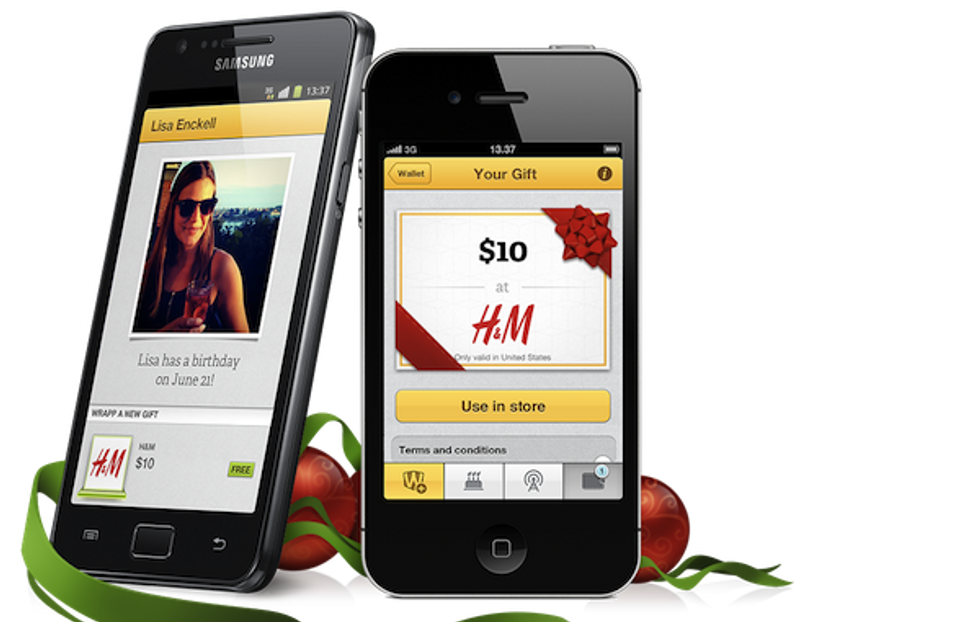As I key in these words, so many gift cards are being exchanged across the US that–if you listen closely–you can almost hear them swishing by, rather like reindeer pulling an invisible sleigh.
It’s estimated to be roughly a $110 billion/year market and the average American now gives about five gift cards per year–the vast majority of them right now, during the holiday shopping season.
Meanwhile, as with so many consumer products and services, gift cards are increasingly going digital, mobile and social.
In that context, from its office near South Park, Wrapp has emerged as the leading gifting app, working with over 180 big-brand retailers like the Gap, H&M, Sephora, and Nike.
But Wrapp didn’t originate in a garage in Palo Alto, built by two guys just out of college.
Instead it first launched in Sweden, by entrepreneurs with experience at Spotify, Rebtel, Sendit, and SoundCloud, in the fall of 2011.
“Sweden served as a great test market for us; it’s small, with a population of only eight million,” explains Wrapp exec Aaron Forth. “After only fifteen months, for one of our retail partners with 150 stores there, we're driving about 15 redemptions per store per day. Five percent of all Swedes already use Wrapp. That’s massive penetration.”
The Swedish team established its US beachhead in SF and launched its nationwide service this past May. Forth and fellow Wrapp exec Greg Spector told me earlier this month that the early growth curve rates in the America are exceeding those in Sweden.
“Our app is social and mobile,” says Forth. “The whole idea is to make it easy for people to give gifts to each other–as easy as it is to wish them happy birthday on Facebook.”
Wrapp draws in new users by offering free gift cards from the merchants, such as a $6 free card from H&M or a one-month free subscription to the Wall Street Journal. As users forward this digital offer to friends and family, it is trackable, generating valuable data both to Wrapp and the partner company.
Wrapp receives a commission only when the recipient makes a purchase, which on average tends to be four to six times the value of the free offer. So consumers are essentially using the free cards to get a discount on purchases.
Paid cards are, of course, also available.
“From the merchants' perspective we are a marketing platform, an alternative to TV or print advertising,” says Forth. “Those channels are less effective now so they need new, trackable ways to drive traffic to their stores. With Wrapp, you send a friend a gift card to a store, driving business to the retailers.”
This is the key to Wrapp’s business model – using an online, viral gifting offer to drive people to the brick-and-mortar stores where Americans still do the overwhelming bulk (93 percent) of their shopping.
Wrapp is developing the capability to leverage the geo-location data on the user’s smartphone to enable unique offers from the merchant to the user in real time.
“In the future, when I'm in the store, my phone will vibrate with a redemption code that can be scanned in that store on the spot,” explains Forth.
With more and more consumers using their phones for shopping, including mobile payments, this would appear to be the wave of the future for both commerce and ecommerce.
Social features include multiple people adding on to the same gift.
“Friends can get together on Facebook and add to a gift,” says Forth. “With the free cards, we're trying to help the merchant by giving the consumer a pre-incentive. On Wrapp, users send about two free cards per week – 20 times more than with paid gift cards.”
“Over the past year, people have sent over seven million gift cards using Wrapp,” added Spector.
And although it’s too early to know what the final volume will turn out to be once this holiday is over, Spector has a pretty good idea that the number will be large, at the rate of over a million per week.
“Gift cards have been the most requested gift the last six holiday seasons running. About six in ten Americans request them.”
Wrapp is available in iOS, android, and on the web. The company says roughly three-quarters of its users are female. Average age: 32.
“Exactly who retailers want,” notes Forth.





















